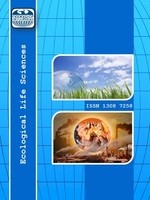TILAPIA (Oreochromis niloticus) BALIĞI DOKULARINDA PROTEİN VE Pb DÜZEYLERİ ÜZERİNE Pb VE Pb+Zn KARIŞIMININ ETKİSİ
Balıklar ekosistem içerisinde insanlar tarafından tüketilen önemli bir protein kaynağıdır. Bu çalışmada Afrika kökenli tatlı su çipurası Oreochromis niloticus’un solungaç ve kas dokularında kurşunun (Pb) toksik etkisi incelenmiştir. Balıklar 7, 14 ve 28 günlük sürelerle Pb (0.1 ve 0.5 mg/L Pb) ve Pb+Zn (çinko)(0.1+0.5 mg/L Pb+Zn ve 0.5+2.5 mg/L Pb+Zn) konsantrasyonlarına maruz bırakılmıştır. Dokuların protein miktarı U.V spektrofotometrik yöntem ile incelenmiştir. Dokulardaki Pb birikimi ise Atomik Absorbsiyon Spektrofotometresiyle belirlenmiştir. Pb ve Pb+Zn etkisinde dokulardaki Pb birikimi kontrol grubuna göre önemli bir şekilde artarken protein düzeyi azalmıştır. Pb birikimi solungaçta daha fazla bulunmuştur. Çalışılan tüm sürelerde Zn’nin O. niloticus dokularında Pb birikimini önemli ölçüde azalttığı saptanmıştır.
Anahtar Kelimeler:
Oreochromis niloticus, Kurşun, Çinko, Protein Düzeyi, Toksisite
___
- Al-Asgah, N.A., Abdel-Warith, A.A., Younis, E.M. and Allam, H.Y., (2015). Haematological and Biochemical Parameters and Tissue Accumulations of Cadmium in Oreochromis niloticus exposed to Various Concentrations of Cadmium Chloride. Saudi Journal of Biological Sciences. Sayı:22(5), ss:543–550.
- Anderson, M.B., Preslan J.E., Jolibois L., Bollinger J.E., and George, W.J., (1997). Bioaccumulation of Lead Nitrate in Red Swamp Clayfish (Procambarus clarkii). Journal of Hazardous Materials, Sayı:54, ss:15-29.
- Begum, G. and Vijayaraghavan, S., (1996). Alterations in Protein Metabolisms of Muscle Tissues in the Fish Clarias batrachus by Commercial Grade Dimethioate. Bulletin of Environmental Contamination and Toxicology, Sayı:57, ss:223-228.
- Blasco, J. and Puppo, J., (1999). Effect of Heavy Metals (Cu, Cd and Pb) on Aspartate and Alanine Aminotransferase in Ruditapes philippinarum (Mollusca: Bivalvia) Comparative Biochemistry and Physiology, Pharmacology, Toxicology and Endocrinology, Sayı:122, ss:253–63.
- Cooper, N.L., Bidwell, J.R., and Kumar, A., (2009). Toxicity of Copper, Lead and Zinc Mixtures to Ceriodaphnia dubai and Daphnia carinata. Ecotoxicology and Environmental Safety, Sayı:72, ss:1523-1528.
- Çoğun, H.Y. ve Kargın, F., (2009). Oreochromis nilotıcus’un Solungaç Kas, Karaciğer ve Böbrek Dokularında Bakır ve Kurşun Birikimi. Ç.Ü. Fen Bilimleri Dergisi, Sayı:21(1), ss:19-29.
- Daka, E.R. and Hawkins S.J., (2006). Interactive Effects of Copper, Cadmium and Lead on Zinc Accumulation in the Gastropod MolluscLittorina saxatilis. Water, Air and Soil Pollution, sayı:171, ss:19-28.
- Duran, S., Tunçsoy, M., Yeşilbudak, B., Ay, Ö., Cicik, B., and Cahit, E., (2015). Metal Accumulation in Various Tissues of Clarias Gariepinus Exposed to Copper, Zinc, Cadmium and Lead Sıngly and in Mıxture. Fresenius Environmental Bulletin. Sayı:24(12c), ss:4738-4742.
- El-Serafy, S.S., Zowail, M.E., Abdel-Hameid Nassr-Allah, H., Awwad M.H., and Omar, E.H., (2013). Effect of diet borne Cu and Cd on body indices of Nile tilapia (Oreochromis niloticus) with emphasis on protein pattern. Turkish Journal of Fisheries and Aquatic Sciences, Sayı:13, ss:593–602.
- Fırat, Ö., Çogun, H.Y., Aslanyavrusu, S., and Kargın, F., (2009). Antioxidant responses and metal accumulation in tissues of Nile tilapia Oreochromis niloticus under Zn, Cd and Zn + Cd exposures. Journal of Applied Toxicology, Sayı:29, ss:295–301.
- Gaspıc, Z.K., Zvonarıc, T., Vrgoc, N., Odzak, N., and Barıc, A., (2002). Cadmium and Lead in Selected Tissues of Two Commercially Important Fish Species from The Adriatic Sea. Water Research, sayı:36, ss:5023-5028.
- Heath, A.G., (1987). Water Pollution and Fish Physiology. CRP Press Inc. 245 s. Florida.
- Hilmy, A.M., El-Domiaty N.A., Daabees A.Y., and Abdel–Latife, H.A., (1987). Toxicity in Tilapia zilli and Clarias lazera (Pisces) Induced by Zinc Seasonally. Comparative Biochemistry and Physiology, Sayı:86C, ss:263-265.
- Kargın, F. and Çoğun, H.Y., (1999). Metal Interactions During Accumulation and Elimination of Zinc and Cadmium in Tissues of the Freshwater Fish Tilapia nilotica Bulletin of Environmental Contamination and Toxicology, Sayı:63, ss:511-519.
- Karthikeyana, S. and Manib, P., (2014). Effect of Heavy Metals on Tissue Protein of an Edible Fish Cirrhinus mrigala as Dependent on pH and Water Hardness, Sayı:59(2), ss:321-325.
- Lowry, O.H., Rosebrough, N.J., Farra N.J., and Randall, R.J., (1951). Protein Measurements with the Folin Phenol Reagent. Journal of Biological Chemistry, Sayı:193, pp:265-275.
- Mason, A.Z. and Jenkins, K.D., (1995). Metal Detoxification İn Aquatic Organisms. In: Tessier, A., Turner, D. (Eds.), Metal Speciation and Bioavailability in Aquatic Systems, ss:479-608. John Wiley and Sons, Chichester, UK.
- Mohamed, F.A. and Gad, N.S., (2008). Environmental pollution induced biochemical changes in tissues of Tilapia zillii, Solea vulgaris and Mugil capito from Lake Qarun, Egypt Global Veterinaria, Sayı:2(6), ss:327-336.
- Muramoto, S., (1983). Elimination of Copper from Cu–Contaminated Fish by Long Term Exposure to EDTA and Freshwater. Journal of Environmental Science and Health, A18 Sayı:(3), ss:455-461.
- Palaniappan, P.R. and Pramod K.S., (2011). The effect of titanium dioxide on the biochemical constituents of the brain of Zebrafish (Danio rerio). An FT-IR study Spectrochimica Acta Molecular and Biomolecular Spectroscopy Part A: Sayı:79, ss:206.
- Remyla, S.R., Ramesh, M., Sajwan, K.S., and Kumar, K.S., (2008). Influence of Zinc on Cadmium Induced Haematological and Biochemical Responses in a Freshwater Teleost Fish Catla catla. Fish Physiology and Biochemistry. Sayı:34, ss:169-174.
- Sharaf-EIdeen, K. and Abdel-Hameid, N.H., (2002). Sublethal effects of copper sulfate, malathion and paraquat on protein pattern of Oreochromis niloticus. Egyptian Journal of Aquatic Biology and Fisheries, Sayı:6(2), ss:167-182.
- Vutukuru, S.S., (2005). Acute Effects of Hexavalent Chromium on Survival, Oxygen Consumption, Hematological Parameters and Some Biochemical Profiles of the Indian Major Carp, Labeo rohita. International Journal of Environmental Research and Public Health, Sayı:2(3), ss:456-462.
- Wallace, W.G., Lee B.G., and Luoma, S.N., (2003). Subcellular Compartmentalization of Cd and Zn in Two Bivalves. I. Significance of Metal-Sensitive Fractions (MSF) and Biologically Detoxified Metal (BDM). Marine Ecology Progress Series, Sayı:249, ss:183-197.
- Wang, W.X. and Rainbow, P.S., (2006). Subcellular Partitioning and The Prediction of Cadmium Toxicity to Aquatic Organisms. Environmental Chemistry, Sayı:3, ss:395-399.
- Zidar, P., Van Gestel, C.A.M., and Strus, J., (2009). Single and Joint Effects of Zn and Cd on Porcellio scaber (Crustacea, Isopoda) Exposed to Artifically Contaminated Food. Ecotoxcology and Environmental Safety, Sayı:72, ss:2075-2082.
- Başlangıç: 2009
- Yayıncı: E-Journal of New World Sciences Academy
